|
This story originally appeared in Railroad
Magazine-originally Railroad Man's Magazine, April, 1949, By Popular
Publications.
This story has been reprinted with Thanks to Carstens Publications.
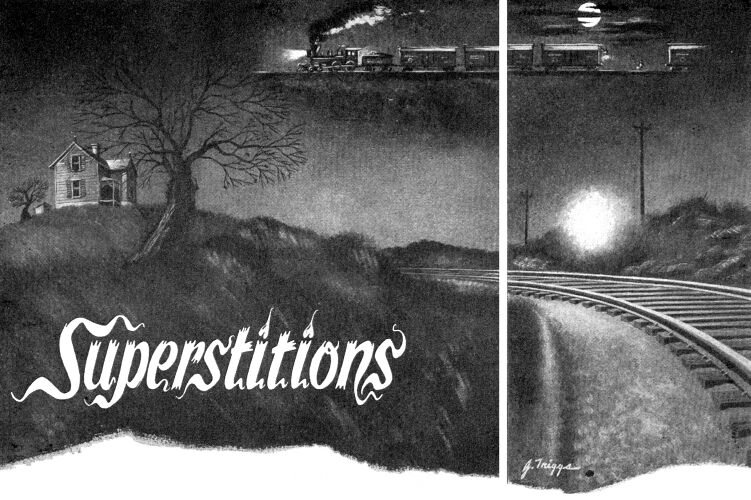
By FREEMAN H. HUBBARD
Fear of the Unknown, Unreasonable Beliefs—
These Are Products of Danger and Death
THE queer light that flickers over the Atlantic Coast Line
at Maco, N. C., fourteen miles west of Wilmington, seems to defy
explanation. It comes and goes at infrequent intervals. Eighty
years ago President Grover Cleveland observed it when his train
on the Wilmington, Manchester & Augusta (now ACL) stopped
at Maco to refuel. A flagman pointed out the glow to the President
and related the grim tale of Joe Baldwin, Back in 1867 poor Joe,
with lantern on arm, had been decapitated in a link-and-pin coupling
accident. When the eerie glow appeared immediately after his death,
men said it was Joe coming back for his head.
A Washington, D.C., scientist investigated this phenomenon
with no success in explaining its origin. An Army machinegun unit
from Fort Bragg, assigned to summer maneuvers at Maco, was likewise
baffled in an effort to solve the mystery. One ACL employee, B.
M. Jones, refers to the ghostly light as weaving directly above
the track to a height of about five feet, describing an arc, and
disappearing in a nearby bog. Another, A. B. Love, says: "Thai
definitely-is not an automobile light on the highway. It lasts
too long, and rises and falls. The effect is visible for five
minutes at a time. Besides, its first appearances antedate the
automobile." Miss Francis Murphy describes its reflection
"shimmering on the rails," and adds, "It is sometimes
light enough to read by."
Many an old head in the railroad game has had experiences he
can't explain on a rational basis. His subconscious mind dwells
in a spirit land of hoodoos and guardian angels, dreams and phantoms,
hunches and unlucky numbers. He believes that in some inexplicable
manner he receives advance warnings of impending disaster. As
a rule these presentiments are too vague for practical use but
on numerous occasions they have led to the saving of human life.
Even in the present realistic age it is not uncommon to find
railroad men carrying in their pockets charms intended to ward
off evil—maybe a rabbit's foot, a four leaf clover, or a
lucky coin or emblem. Your author met a young fireman in the St.
Louis Terminal yards who attached some importance to a buffalo
nickel he had picked up outside a roundhouse the first day he
went firing.
"I keep it for luck," he said. But he laughed at
a crack about superstition.
"Not me, brother! I don't go for that stuff."
Plenty of rails who "don't go for that stuff" will
nevertheless knock wood while boasting or will sedulously avoid
being one of "three on a match." Men of the roaring
road, especially the oldsters, are guided by superstition to a
greater extent than they care to admit. The same applies, of course,
to others whose work is strenuous and tinged with danger or chance—sailors,
deep-sea fishermen, lumberjacks, cowboys, miners, gamblers, even
baseball players.
Some years ago, a Southern engineer named Sam Musgrove was
sauntering over to the Atlanta roundhouse to report for duty when
a large black tomcat slunk from behind a wall just in front of
him, meowing as if to ask:
"Going out? Going out?"
The hogger spluttered: "Hell, no'! I'm going back home."
And he did.
A fellow workman must have witnessed the affair, for when Sam
appeared at the roundhouse two days later he was greeted with
catcalls and yells of "Hi-ya, Black Cat!" He went over
to his engine, a Consolidation-type. The boys had painted on the
boilerplate a picture of a cat with its back arched, and had fastened
it to the headlight bracket. Sam laughed as loudly as the rest,
his friend, Herbert G. Monroe tells us, but thereafter the name
"Black Cat" clung to him like tinsel to a Christmas
tree.
Superstitions often start with some incident which in itself
would have no effect upon analytical minds. Repetitions of such
incidents may breed a fear that becomes chronic. A locomotive
involved in one or more wrecks is supposed to be jinxed, especially
if she has a 13 or a 9 in her number. Enginemen fight shy of her.
Many refuse to handle a number 13, or begin a run on Friday the
13th, or have anything to do with 13.
You often hear of accidents that happen to engines numbered
13, but there is no reason to believe that these engines have
more than their share of misfortunes. The mishaps to l3s are just
publicized more than the others. The most baffling holdup in rail
history was staged by thirteen bandits who robbed a Union Pacific
express of $60,000 in gold at Big Spring, Neb., in 1887. Not one
of the mysterious thirteen was ever identified or captured!
Long ago, superstition decreed that no locomotive should be
turned to the left as she rumbled out of the roundhouse onto the
turntable. September, the ninth month, was considered the fatal
month in railroading. That might have been because the first train
fatality occurred on a September day in 1830, when a British Parliament
member fell under the wheels of George Stephenson's Rocket.
A checkup of famous rail disasters shows that more of them happened
in summer than at any other season. No wonder sighs of relief
went up year after year when September's page was torn off the
calendar, indicating that no more summer excursions would be run
till the roses bloomed again. The ninth month was believed to
be jinxed.
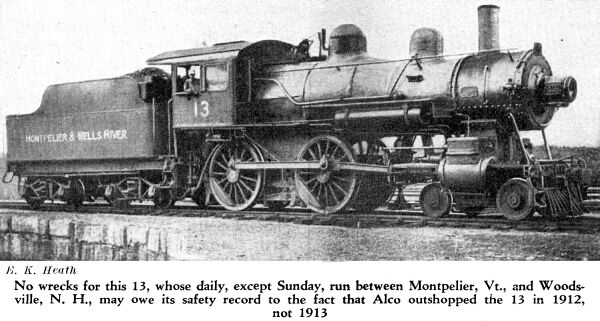 SOME veteran
trainmen refuse to sweep out cabooses after dark, lest they bring
bad luck. Engineers have a superstition that it is unlucky to
step onto the cab with left foot first. There is a reason for
this. You mount the cab on the right side with the oil can in
your left hand. You swing aboard with your right paw clutching
the grab-iron on the cab's right side. If you tried to barge in
with your left foot first, you'd have to cross your feet over,
or stumble. SOME veteran
trainmen refuse to sweep out cabooses after dark, lest they bring
bad luck. Engineers have a superstition that it is unlucky to
step onto the cab with left foot first. There is a reason for
this. You mount the cab on the right side with the oil can in
your left hand. You swing aboard with your right paw clutching
the grab-iron on the cab's right side. If you tried to barge in
with your left foot first, you'd have to cross your feet over,
or stumble.
When a switchman kicks his foot in a switchfrog, that also
is regarded as a bad omen. He invariably goes back and steps over
it again, to avoid getting his foot caught in it the next time.
When a new man trips over a tie or rail, a seasoned railroader
will call him back and make him step high over it "for the
good of the service." This is no mere superstition: it is
a matter of training the green hind in safety habits.
Seaside folk have a belief that births occur at flood tide
and deaths at ebb, on the theory that life comes and goes with
the tide. In railroading, we have the strange case of James Luther
Shull. Jim was born in the year that the Waynesburg & Washington
narrow-gage line was projected. When he grew up, he worked for
the W&W, first as brakeman, then as conductor, as long as
the narrow-gage operated, and finally passed away on the very
day it folded up!
Whether or not Jim Shull consciously identified his life with
that of the "Waynie" is a topic for speculation, but
grief over its fate was more than he could bear. On June 10, 1929,
when the last narrow-gage train was filling up with passengers
at Waynesburg, Pa., the aged conductor showed up as usual to collect
fares, but declined to go aboard. A brakeman took his place. Left
behind, Jim watched the little engine and cars round a curve.
Then he slumped to the platform and expired of a heart attack.
That train, like the grandfather's clock "stopped, never
to run again, when the old man died."
Death and superstition are twin sisters. Morris D. Donovan,
Louisville & Nashville engineer, told of a dark night when
he saw an object resembling a corpse on a lone siding.
Ike was aghast. "Jes' a miles from Bessemer, Ala. The
crew talked it over. They decided to leave Ike Fulton, their colored
brakeman, with the body while they highballed to Bessemer for
the coroner.
Ike was aghast, "Jes' a minute, boss!" he protested.
"How long will it take you all to reach Bessemer?"
"About eight minutes," said Donovan. "Why?"
"Well, if you all leave me in the dark with any daid man
you's gwine to find me on the depot platform at Bessemer, waitin'
for you all when you get theah."
A common custom in bygone days was to lay on trainmen's graves
floral tributes shaped like a broken wheel. This practice originated
in 1887, when "Long John" Simpkins, conductor on a Colorado
& Southern coal run, gave his life to keep a string of runaway
cars from crashing into a passenger train, and a shattered brake
wheel was found clutched in his stiff hands. The wheel was buried
with him.
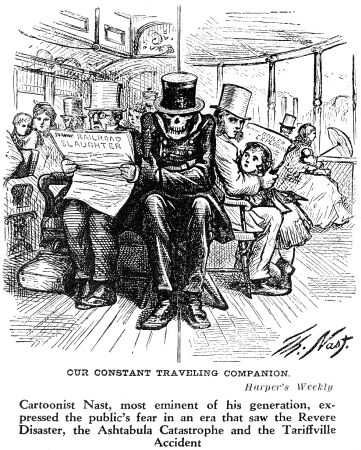 "Rails
who attended the funeral," commented Aden Donnelly, "thought
that if this grim souvenir did not give John a clear board through
the Pearly Gates, they themselves would stand a mighty slim chance
at the end of life's run." "Rails
who attended the funeral," commented Aden Donnelly, "thought
that if this grim souvenir did not give John a clear board through
the Pearly Gates, they themselves would stand a mighty slim chance
at the end of life's run."
The belief that accidents occur in series of three lay at the
heart of the Kate Shelley saga, Kate's father, you may remember
had been a Chicago & North Western section hand who went to
glory in a wreck beside the Des Moines River. Her brother Mike
had later been drowned there. Kate had been reared in rail superstitions.
She hesitated on the river bank that stormy night of July 6, 1881,
she said afterward, because she feared she might be the third
member of her family to perish there. It took real courage for
a girl of fifteen to conquer that phobia and save the Limited.
Nearly three years later another child of fifteen, H. D. Ballanger,
was riding a Denver & Rio Grande narrow-gage train when, to
his horror, he saw a switchman's foot crushed in a link-and-pin
coupling. Then he overheard this conversation between the conductor
and the flagman:
"That makes two accidents in three days. Remember that
new brakeman, day before yesterday, who was killed not far from
here? They're holding the funeral tomorrow."
"Yeah, I know."
"Two accidents in a row. That makes—"
"Don't say it, fella!" interrupted the conductor.
"I don't believe in jinxes anyhow." But his anxiety
belied his words.
As the train neared Cimarron, Colo., a huge boulder slid down
onto the track. The conductor cried, "My God, it's come!"
The ponderous mass smashed a trestle over the Gunnison River,
killing the engineer and injuring the fireman. Fate had taken
its toll of three in a row!
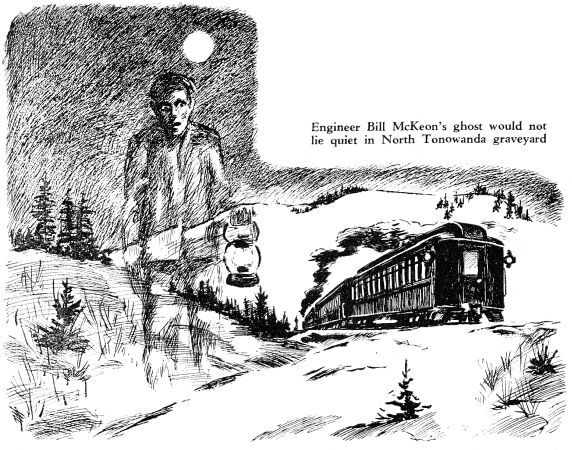 Turn now to
March, 1888. There had been two train wrecks that winter of the
big blizzard on the New York Central's Batavia to North Tonawanda
branch, and Bill McKeon was not at all happy at being called to
push a snow-plow over the branch. He and his tallowpot, Fred Hunt,
discussed the matter in their boarding house at Batavia, N. Y.
The conversation, as reported by Ward Adair, an Erie brass-pounder,
ran about like this: Turn now to
March, 1888. There had been two train wrecks that winter of the
big blizzard on the New York Central's Batavia to North Tonawanda
branch, and Bill McKeon was not at all happy at being called to
push a snow-plow over the branch. He and his tallowpot, Fred Hunt,
discussed the matter in their boarding house at Batavia, N. Y.
The conversation, as reported by Ward Adair, an Erie brass-pounder,
ran about like this:
"Fred, I don't like the idea of goin' out tomorrow. We've
both railroaded long enough to know that wreck number three ain't
far away, and somethin' says it'll get me.
The fireboy slapped his shoulder. "Brace tip, Bill! Of
course we know there'll be a third one, but nobody knows where,
and they can't get us till our time comes. To my way of thinkin',
nothin' can kill you or me until the hands of the clock point
to the second when we've gotta die—and that may not be for
a hundred years yet."
Bill's number was called the very next day. Just as he took
out his watch to glance at the time, his engine skidded off the
icy rails into the snow, water and muck of Black Ash Swamp. He
died at the throttle. They laid his body to rest in the North
Tonawanda graveyard to await the last trumpet call of Judgment
Day.
But exactly one year after the tragedy, farmer folk living
near the swamp began talk of a specter with a lantern patrolling
the wreck scene at night. They said it was Bill McKeon's ghost.
For some reason or other, they whispered around the hot coalstove
in the general store, the engineer's spirit was restless.
Tall tales multiplied. A badly scared visitor from Indian Falls
vowed he had seen a demon with glowing eyeballs who swung a lantern.
The mixed-train crew claimed they were late one night because
they dared not run down the track-walking apparition. On another
occasion an eagle-eye highballed boldly ahead, but said the misty
figure dissolved with a blood-curdling yell. Sleighing parties
who drove to the swamp after dark insisted they had seen 4 peculiar
light.
This went on, we are told, year after year, each visitation
occurring on the wreck anniversary and lasting for a month. Some
said the nightly jaunts were marked by shooting stars and blood
on the moon, that the belanterned shade with phosphorescent eyes
invaded a barn, terrifying the farmer out of his wits. Old Bill
McKeon appeared to be looking for something—but what?
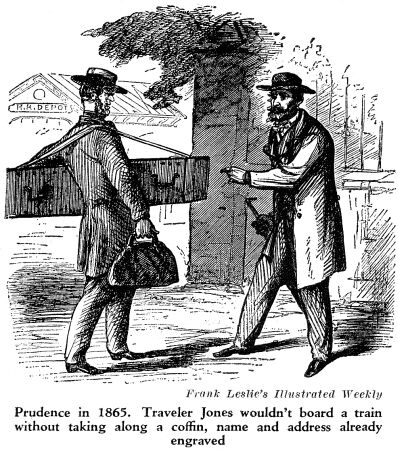 At length Fred
Hunt, the fireman who had saved his life by joining the birds
that fatal night when Bill's engine dug a hole in the mire, declared
that the hoghead was after his missing watch. Parties searched
the vicinity. They found the man who had picked up this watch.
Then one cold moonlit evening they placed it on the snow beside
the gleaming rails. Legend has it that the wraith of Black Ash
Swamp drifted along the right-of -way that night as usual, stopped
in front of the watch, then picked up the timepiece and shot the
lantern up, up, up till it was lost to sight in the stars. After
that, neither ghost nor watch was ever seen again. At length Fred
Hunt, the fireman who had saved his life by joining the birds
that fatal night when Bill's engine dug a hole in the mire, declared
that the hoghead was after his missing watch. Parties searched
the vicinity. They found the man who had picked up this watch.
Then one cold moonlit evening they placed it on the snow beside
the gleaming rails. Legend has it that the wraith of Black Ash
Swamp drifted along the right-of -way that night as usual, stopped
in front of the watch, then picked up the timepiece and shot the
lantern up, up, up till it was lost to sight in the stars. After
that, neither ghost nor watch was ever seen again.
THESE ghost legends spring up almost invariably in sparsely
settled areas. Take the phantom of Lewiston Narrows. In the annals
of train robbery you find extremely few lone-wolf bandits. Among
these was the never-identified outlaw who held up a Pennsy train,
the Pittsburgh and Northern Express, in the early morning
darkness of August 31, 1909. The scene: a wilderness in the Alleghenies,
miles from a house. On one side of the track ran a state pike,
a canal tow-path and the bluish-green Juniata River. On the other,
a sheer, impassable mountain wall.
The robber wore a black slouch hat draped with gunnysack that
covered most of his short, squat body. He stopped the train with
torpedoes. From a baggage car he took, at gun's point, a bag of
coins that he probably thought were gold; They were shiny new
Lincoln pennies, $65 worth. He passed up half a million dollars
in bank notes. A pack of bloodhounds borrowed from the Baltimore
& Ohio picked up the scent but whimpered and turned tail.
Folks said a wraith had frightened them. As time went on, wondrous
tales were related of a specter seen walking the track or lurking
behind the jagged, rocks of Black Log Mountain. They declared
it was looking for the half-million dollars.
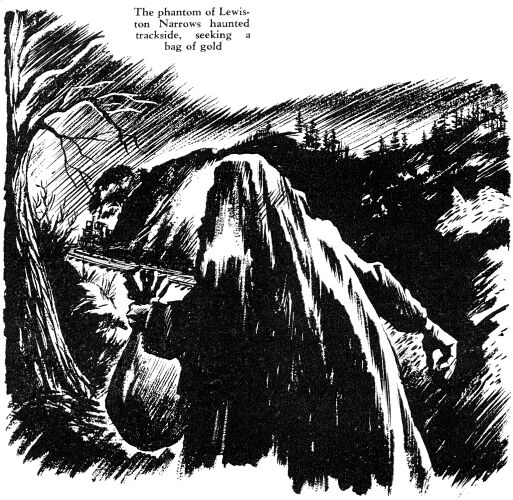 Another trackside,
specter was reported to haunt the lone Confederate soldier's grave
just north of. Allatoona Pass, down Georgia way, on the old Western
& Atlantic (now NC&StL). Engineer Polly Milan went back
there to flag one dark night after his train had broken in two.
He said the apparition walked over to him out of a deep spooky-looking
cut and even sat down on the ties. Milan mustered courage to address
the figure and, even tried to touch it, but quickly lost his nerve
and fled. Another trackside,
specter was reported to haunt the lone Confederate soldier's grave
just north of. Allatoona Pass, down Georgia way, on the old Western
& Atlantic (now NC&StL). Engineer Polly Milan went back
there to flag one dark night after his train had broken in two.
He said the apparition walked over to him out of a deep spooky-looking
cut and even sat down on the ties. Milan mustered courage to address
the figure and, even tried to touch it, but quickly lost his nerve
and fled.
The Santa Fe also has a ghost story connected with a trackside
grave. A Mexican woman slain by her husband was buried beside
the east switch at Manuelito, N.. M. Superstitious Mexicans shun
the spot. They insist the lady's spirit dances by moonlight. One
night two Santa Fe freight brakemen decided to play a practical
joke on their flagman. While the train was waiting for a meet
with a westbound passenger, they daubed a girl's shoe with phosphorus
and set it on the grave. One of them hid in the bushes and uttered
a hollow groan just as the train pulled out of the siding and
the flagman got off as usual to close the switch. The flagman
was scared. Making a dash for the caboose, he swore he had seen
a woman's shoe dancing in the darkness. For months afterward,
friends kidded him.
Along the same lines is Herbert Monroe's account of the railroad
inn at Babahatchie, Tenn. So great was the demand for beds there
around the turn of the century that some of the beds practically
never got cold. Men waited outside the bedroom doors, ready to
stampede for a bed the moment its occupant left. One enterprising
engineer, Tom Snyder, got beds for himself and three pals by posing
as the ghost of a fireman who had died at the inn a few days before.
Present-day railroaders are less superstitious. If they got
up at all it would be to whale the tar out of the "spook"
who had so rudely disturbed their sleep.
Not all ghost stories are funny. One day a heavy Santa Fe freight
stopped at Trinidad, Colo., by the foot of Raton Pass. The conductor
asked his rear brakeman:
"Who was the third man that helped you to set brakes?"
Nobody knew. This incident was repeated again and again. At
the critical time when a train was descending the treacherous
grade, the phantom would appear and help to tie 'em down, vanishing
as soon as the danger was over.
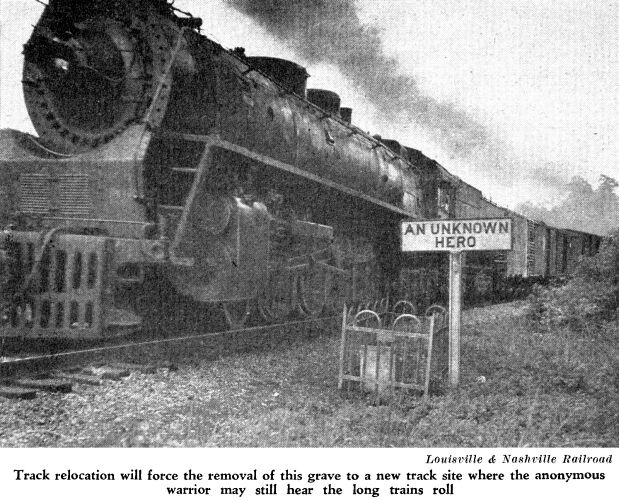 The mystery
was solved one winter night when a hobo, forced to unload from
a freight, spitefully turned an angle-cock in the trainline. The
train ran wildly downhill and piled up at the bottom. All the
crew jumped, but not the phantom. That strange figure was seen
tying down brakes till the very last. His body was identified
as that of Bill Rogers, a brakeman who had been thought mangled
to death in a wreck three months before. His friends had buried
the wrong man, and Bill had lived on, out of his mind. The mystery
was solved one winter night when a hobo, forced to unload from
a freight, spitefully turned an angle-cock in the trainline. The
train ran wildly downhill and piled up at the bottom. All the
crew jumped, but not the phantom. That strange figure was seen
tying down brakes till the very last. His body was identified
as that of Bill Rogers, a brakeman who had been thought mangled
to death in a wreck three months before. His friends had buried
the wrong man, and Bill had lived on, out of his mind.
Unlike the Raton Pass mystery, the case cited by J. H. Holbrook
has never been cleared up. "In the fall of 1907," he
reminisced, "I was a kid breaking ahead on local freight
between Argenta and Brinkley, Ark., on the Rock Island's Arkansas
Division. One morning as we rounded a curve eight miles east of
Argenta, our tallowpot saw the head shack. Johnny Marsden, walking
over the car tops ready to head us in at Galloway for a meet with
an eastbound train. He slipped, and the wheels rolled over him.
"Several days after the funeral, I was flagging one night
at Lonoke, twenty miles east of Argenta. I had just stopped an
eastbound passenger train, Number 44, and was standing on the
track chewing the fat with crew members when I happened to glance
down the main toward the village of Kerr and saw a white lantern
approaching around the curve.
"I figured it was one of the other local brakemen flagging
over to see what was causing the delay, so I started walking to
meet him. But when I arrived about a. quarter-mile from the glim,
the light turned off down the hill side and vanished. The hair
on my neck rose. Nevertheless, I continued on to where I thought
the lantern had gone, but could see neither man nor light. Then
I returned to my train at Galloway—and don't think I dragged
my feet any on the way, back.
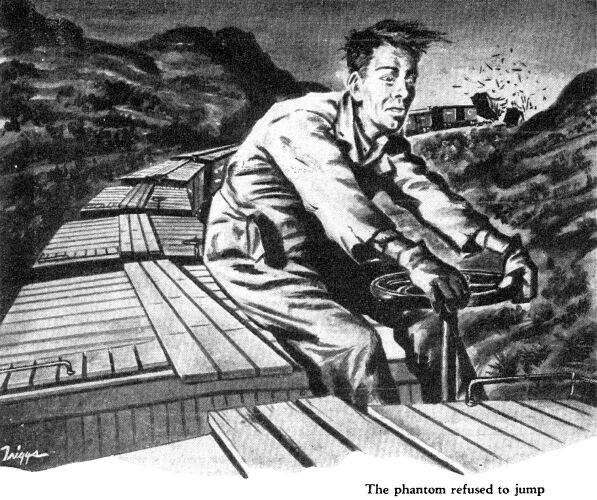 "All of
44's crew had witnessed the same oddity. We knew it wasn't hallucination,
though none of us could account for it. Well, we stayed at Galloway
till sunrise. The porter and I then walked a flag around the curve,
and Number 44 followed us over to Kerr. There we found the local
waiting for us, the one we'd been expecting. Their conductor had
run into some trouble and had gone back for orders. "All of
44's crew had witnessed the same oddity. We knew it wasn't hallucination,
though none of us could account for it. Well, we stayed at Galloway
till sunrise. The porter and I then walked a flag around the curve,
and Number 44 followed us over to Kerr. There we found the local
waiting for us, the one we'd been expecting. Their conductor had
run into some trouble and had gone back for orders.
"After we had sawed by, I asked the local's head end,
'Who walked around the curve with a lantern last night?' All of
the crew assured me that none of them had done so. The mystery
was never solved. If I were superstitious I might think it was
Johnny Marsden's ghost making his way over the train to head us
in at Galloway, as the real Johnny had done several months before."
This narrative brings to mind the poem, GHOST STORY, by J.
E. Aldrich, which begins as follows:
"There was a wreck on the Western branch
At the heel of the Devil's Stair
(I've heard 'twas caused by all avalanche)
Arid a brakeman perished there.
He perished there by a rock or a wheel,
And his wraith was riven free,
But it comes each night, as we pass the heel,
To walk on the cars with me."
PHANTOMS, dreams and hunches—the border line between them
is thin and wavering, and nobody knows just where it begins or
where it ends. Even that tough, old, retired boomer, Charles Anthony
Roach, known as "Silent Slim," admits he was and still
is puzzled by an incident that occurred nearly sixty years ago
when he was a youngster firing a yard goat on the Chesapeake,
Ohio & Southwestern (now Illinois Central) at Paducah, Ky.
One day a fellow fireman, Tom Long, remarked:
"You know, Slim, I've had a queer thing happen to me for
several trips. I don't know what to think. It has to do with the
high trestle that crosses Chestnut Creek about nine miles from
here. Every time we roll over that trestle I am wide awake and
on the job. But for three days in succession I've had a daydream
just at that place. I seem to see the rails buckle and break into
splinters—all of this right in front of the pilot while we
are highballing at around thirty miles per hour. I told my engineer,
Roberts, about it and he only laughed. But I feel that it's a
warning."
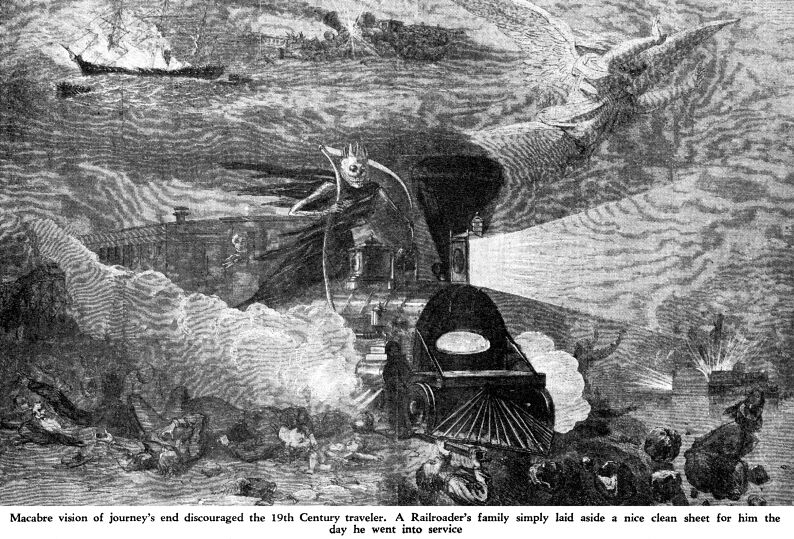
Slim didn't laugh. He was glad later that he hadn't. On Tom's
next trip across that trestle in broad daylight the rails did
what his dream had foretold. The trestle buckled and collapsed.
Down went the engine, Number 136, into the creek, 17 boxcars piling
on top. Nobody was killed, but both enginemen were crippled. It
was three or four months before Tom could walk again.
Yes, tragedy often stalks in the wake of dreams. Take the case
of John A. Cheaves. John was a Southern engineer who lived in
Atlanta with his wife, his daughter and his brother-in-law, Herbert
Monroe. Death came to him in a nightmare a few days before the
night of August 23, 1907, but John refused to do anything about
it.
Herbert tells the story: "A callboy rapped on our door
that night. John was wanted to wheel a freight to Birmingham.
I saw his face cloud up. He must have been thinking of that nightmare,
but times were hard, calls were often far apart. He signed the
book. John was a six-footer. As my mother came into the parlor
to invite him to supper, he remarked with a faint smile: 'Mother,
wouldn't I make a long corpse?' Mother, not knowing his uneasiness',
passed it off as a joke. But at the supper table, when he dropped
his knife and fork and stared into space, she sensed that something
was wrong.
" 'Somehow,' he said, 'I dread going out tonight.'
" 'Then stay home, son,' she pleaded. 'A terrible thing
might happen to you.'
"John forced a laugh. 'Don't worry, mother; no engine
is going to hurt me.'
"A few minutes later he kissed his wife and daughter and
strode rapidly up the street. He paused at the corner, where the
old carbon light was burning, and waved a last farewell as we
stood at the sidewalk gate. Just before daybreak next morning
his body was found in the wreckage of a cornfield meet. I still
have the well-thumbed Bible he carried; he had penciled several
passages referring to death."
Another engineer who had a premonition of death in the cab
was Billy Richardson, Chesapeake & Ohio veteran. On December
13, 1910, as Billy was about to pull out of Huntington, W. Va.,
with the Fast Flying Virginian, a friend remarked: "Well,
Billy, I guess you'll stay on this run until it finally gets you."
The hogger tried to laugh it off, but later, said to his fireboy,
J. C. Lively:
"Buddy, people don't seem to realize how it makes a man
feel to start out on the road with such a remark ringing in his
ears. We never know what lies around the next curve. I believe
we all have a time and a way to go. If mine must be in the engine
cab, then I am ready."
Four days afterward he was killed in his cab by a mail crane.
His presentiment of death was memorialized in a poem, Billy
Richardson's Last Ride, by A. Meeker.
Coming now to February 8, 1939, we find Henry F. Miller, a
Chicago Great Western engineer; seated in the kitchen in the home
of a fellow hogger, E. N Kattenberg, at Council Bluffs, Iowa.
Miller had been boarding with his friend for sixteen years. His
back was to the window when a white pigeon flew toward the glass
and fluttered around, evidently looking for food.
"That's a bad sign," warned Mrs. Kattenberg. "Get
away from the window!"
Miller chuckled. He wasn't at all worried, but to please the
lady he ambled into the sun parlor. Presently, he lay down on
the sofa for a nap. It seemed that the bird followed him outside
the house and again perched on the window nearest to him. Later,
when Miller put on his shoes to go to work for the night, he said
they felt unusually heavy—possibly from the slush—and
asked Mrs. Kattenberg to lift them and judge for herself. She
did so and confided to her husband afterward that this was another
bad sign. But the boarder gave no inkling that he expected trouble.
At 10:30 that night he and his fireman were killed in a head-on
collision a few miles west of Tennant, Iowa. The other engineer,
badly scalded, was rushed to a hospital.
Kattenberg recalls: "At the time of the wreck, I was on
the opposite run from Henry. Had the accident happened the night
before, the funeral would almost certainly have been mine instead
of his. With some trepidation I went on my turn on the 19th, so
cautiously that, as I told some, of the boys, I could have rolled
a keg of whisky over the Division faster than I piloted the engine
on that run.
"Reaching Minneapolis in the morning, I phoned my wife
to reassure her that I was all right. Then she told me, via long
distance, that Henry Miller's spirit had come back during the
night, opening the door of her bedroom and making his way through
the moonlight to a chair by her bed. He wore the same clothes
he'd had on the night of the wreck, she said, but his face was
black and pitted from the scalding."
Sometimes an engineer saves his life by obeying a hunch. For
example, take Louis Patrick of the Canadian Pacific in the year
1908. Lou's wife had the feeling that something dreadful was going
to happen to his engine that night and begged him to decline the
call. The eagle-eye was not convinced, but agreed to do as she
requested. A younger man took the run. An hour later, he and his
fireman were killed by a rock slide. Another CPR engineer who
heeded intuition was Duke McKenzie. Duke was wheeling an express
through Fraser Canyon of an early morning when he spied a tiny
dust cloud around a bend. Hunch warned him to "wipe the clock."
He ground to a sudden stop, his pilot edging into a mountain slide.
An Erie hogger, James Deegan, likewise respected a hunch. One
night many years ago he stopped his engine at Kouts, Ind., at
the point where the Erie crossed the Panhandle. A high wind had
blown out the switch and semaphore lights and even his headlight,
all of which burned oil. All lights governing the Kouts interlocking
system also were out. The conductor nervously walked up to the
engine. Presently the towerman gave a signal, of which Deegan
caught only a part.
"All right," said the skipper. "Let's go!"
Still the engineer waited. The towerman came out and pumped
his lantern up and down. Deegan reached for the throttle, but
confided later that be seemed to feel a pressure on his shoulder
and hear a voice whisper: "Don't go, Jim!" He looked
around, saw no one.
"What's the matter Jim?" the conductor demanded.
"Why don't you go?" "How do I know but what that
signal was for a Panhandle train?" he asked.
Neither of the two men saw anything on the Panhandle track,
but the inner message was so imperative that Deegan waited. Then
they heard a Panhandle train rumble over the crossing! Obeying
that hunch had prevented a wreck. The towerman, unknown to the
Erie engine crew, had actually been signaling the Panhandle train.
IT IS plain that rails put too much faith in their premonitions
to treat them lightly. One more instance:
On a summer night in 1915, R. D. Connor, a B&O section man,
was deadheading upgrade on a loaded coal car to Blaser, W. Va.,
when he got a presentiment that the train was going to be wrecked.
He unloaded at Trey Run bridge and caught the bind end, which
happened to be the pilot of a Mallet helper. A few minutes later
two boxcars telescoped themselves in a cut and almost instantly
a violent hailstorm of coal fell upon the car he had just vacated.
Nobody was hurt, but Connor does not like to think what might
have happened to him if he had ignored the hunch.
Sometimes the premonition concerns a relative or friend. Gilbert
Fournier was braking on the smoky end of a Maine Central extra
out of Rumford, Maine, and told his fireman, Doby White:
"I feel there's something bad in store for me." Sure
enough, when they stopped at Mechanic Falls and took water, the
Agent said:
"Gil, you've just lost one of your best friends, Bill Lovejoy;
He was caught between two drawbars while switching at Rumford
junction and killed instantly."
Fournier declared later: "I've often had this feeling
of dread, once just before my father met death—also on the
Maine Central."
An unusual form of bunch was vouchsafed to Charles Wulff, a
Chicago & Eastern Illinois engineer. In 1926 Charlie was leaving
Chicago Heights at one a.m. when he had a weird sensation. In
that instant his engine stopped, apparently for no reason. He
got down and, looked her over but could find nothing wrong. Next
morning he heard that his father had died at the very time his
engine mysteriously stopped.
Another example of hunches that had no practical value came
to Walter A. Seidel, Illinois Central train dispatcher at Dubuque,
Iowa, one summer day in 1903. A, sense of impending disaster oppressed
him at the breakfast table and grew stronger as the hours passed.
He kept an exceptionally sharp watch on the orders he issued.
But at 10:53 that night an, eastbound livestock train collided
head-on with a westbound coal drag on a sharp curve near Scales
Mound, killing the fireman and injuring several crew members.
There was nothing that Walter could have done to avert that cornfield
meet, for the hogger on the coal drag had fallen asleep in his
cab.
Train wrecks form a rich soil in which the weeds of superstition
grow. Many a railroad station located near the scene of a much
publicized disaster has been renamed to banish the jinx. On October
10, 1888, the sixth section of a Lehigh Valley excursion plowed
into the rear of the fifth section midway between Penn Haven junction
and White Haven, Pa. Of the 64 persons killed that night, 29 had
come from the same village, Pleasant Valley, six miles from Scranton.
The name was promptly changed to Avoca. 'You would look in vain
' today for "Pleasant Valley" on a Pennsylvania map.
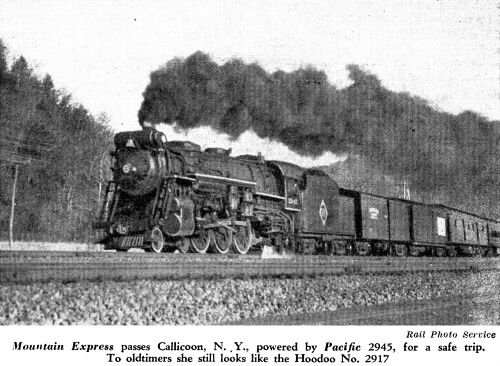 By the same
token, plenty of engines have been renumbered to get rid of a
stigma. The Erie's 2917, for instance, had been in a series of
accidents in which crew men were killed and was generally regarded
as a hoodoo until the company obligingly renumbered her 2945,
which is her number today. By the same
token, plenty of engines have been renumbered to get rid of a
stigma. The Erie's 2917, for instance, had been in a series of
accidents in which crew men were killed and was generally regarded
as a hoodoo until the company obligingly renumbered her 2945,
which is her number today.
The Illinois Central, rebuilt Casey Jone's last engine, Number
382, and put her back into service on The Cannonball, but
she acted so strangely that the boys said she was jinxed. The
old girl ran into one accident after another, sometimes with fatal
results. As if endowed with a grim sense of humor, she turned
over beside the Memphis Coffin Works. The company changed her
number successively to 212, 2012 and finally 5012, but even that
did not break the spell. In 1933 she was scrapped. On her way
to the boneyard, Casey's pet took one last fling, jumping the
rails and sending another fireman to glory.
No list of hoodooed engines would be complete without those
numbered 13 on, the Cairo & St. Louis, the Iowa Central, the
Kansas Pacific, the Cairo & Vincennes and the St. Louis, Kansas
City & Northern. Also the Illinois Central's 113, the Colorado
'Midland's 22, and that killerdiller, Number 107 of the Denver
& Rio Grande. But before considering them, let us glance at
a hoodoo necklace.
The story dates back to around the turn of the century. Ras
Robinson, conductor, was running a train on the Creston branch
of the Kansas City, St. Joseph & Council Bluffs (now Burlington
Route). Just as they pulled out of Maryville, Mo., he tried to
collect fare from a young woman passenger who said she had no
money.
"I'm sorry, miss," he apologized, "but I'll
have to put you off the train," and he reached for the bellcord.
"Wait!" she pleaded. "Here, take this gold chain
necklace! It's worth a lot more than the fare. Hold it for me
till I can afford to redeem it."
Ras agreed, but lived to regret the bargaln. That necklace
proved to be a jinx. The girl never did redeem it. One night,
while Ras was carrying the necklace in his pocket, his train was
delayed by a cornfield meet of two freights right in front of
him. Shortly afterward his train hit a flock of sheep and the
engine was ditched. Two days later his engine blew out a cylinder
head near Barnard, Mo. They disconnected her and she pulled into
St. Joe working one side.
The next trip out they hit a farm wagon, and the company had
to pay damages. Then one day they pulled out of Creston, Iowa,
more than half an hour late, having been held up by a mainline
Q train, and were trying to make up lost time when a hotbox on
the mailcar caused them to tie up the road. Finally Ras's train
struck a scrub steer, and the company had to pay for a thoroughbred
Holstein. By this time the conductor decided he had kept the necklace
long enough, so he pawned it. He never saw the girl again. As
for the hoodoo necklace, Ras came to the conclusion that it had
been stolen.
It was easier to get rid of a necklace than a jinxed locomotive.
The Cairo & Vincennes (now Big Four) had a 13 that played
tricks. She climbed the rails and headed for a platform on which
were piled boxes of high explosives. Her crew unloaded rapidly,
but the engine fooled 'em. She stopped suddenly with her pilot
only 4 foot from the dynamite. On her next trip she again left
the rails. This time she turned over and rolled down the bank
into the Ohio River near Mound City, Ill. Nobody was hurt. Later,
she ran off the levee at Cairo into the same river, smashing an
Anchor Line barge. Her next mis-adventure was to toss a steer
into a ditch, damaging herself so badly that she had to be shopped.
Rebuilt, she came out with a new number, and the spell was broken.
The Cairo & St. Louis (now GM&O) had a top-heavy Baldwin
numbered 13. Tradition says she seldom made a roundtrip between
East Carondelet, Ill., and Murphysboro, Ill., without leaving
the rails. Regardless of which crew took her out, the result was
the same. And Number 13 of the Iowa Central (now M&StL) had
an equally disgraceful record, but after running through a bridge
she was overhauled and renumbered, and from that time on gave
no further trouble.
Back in the 1870s, the Kansas Pacific (now Union Pacific) had
a Hinckley-built 13 that ran into a series of misfortunes, such
as being delayed for, hours by a herd of buffalo and then attacked
by Sioux Indians, until she was given a new number and the jinx
was lifted. Another cantankerous 13 ran on the St. Louis, Kansas
City & Northern (now Wabash), on the Richmond St. Joseph branch.
It was common practice to send out green firemen on her for their
first few trips, and this Rogers engine tried the nerves of the
best of them. Many a time she stubbornly refused to steam, no
matter how much they coaxed her. They had to keep the blower on
in order to raise enough fog to get her over the road. A fireman
could scatter coal as nicely as he pleased; he could crack it
into little pieces; he could dump it in heaps and humps—it
made no difference with her steaming. Delays were frequent, and
crews were rawhided by the brass hats. What eventually happened
to this hoodoo is not a matter of record.
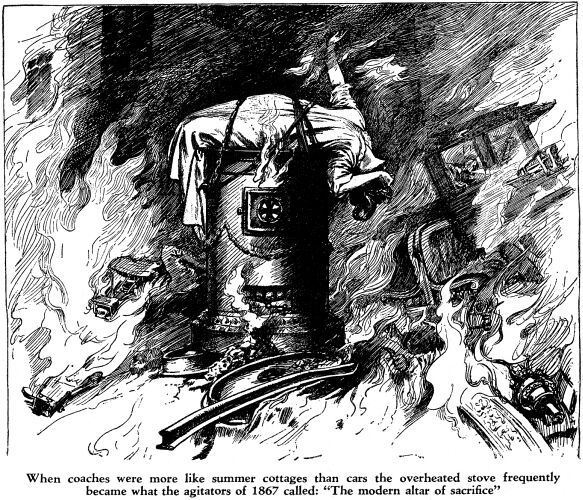 Many years ago,
the Illinois Central had a Number 113 running between Centralia
and Cairo. She too was believed to have been jinxed. Four miles
north of Carbondale, Ill., the line crossed the Big Muddy on an
iron bridge. Engineer Walter Marsh was coming north with Number
113 on a through freight when the bridge gave way and the tail
end of his train fell down into the river. The tender coupling
snapped, and at least half, of the train stayed on the rails.
Number 113 jumped ahead like a scared jackrabbit and ran away.
Marsh shut her off, but she highballed halfway to DuQuoin before
he could stop her. Then he tried to back down to the wreck; she
would not budge an inch. She would go ahead all right, but the
instant he attempted to reverse her she stopped dead. Many years ago,
the Illinois Central had a Number 113 running between Centralia
and Cairo. She too was believed to have been jinxed. Four miles
north of Carbondale, Ill., the line crossed the Big Muddy on an
iron bridge. Engineer Walter Marsh was coming north with Number
113 on a through freight when the bridge gave way and the tail
end of his train fell down into the river. The tender coupling
snapped, and at least half, of the train stayed on the rails.
Number 113 jumped ahead like a scared jackrabbit and ran away.
Marsh shut her off, but she highballed halfway to DuQuoin before
he could stop her. Then he tried to back down to the wreck; she
would not budge an inch. She would go ahead all right, but the
instant he attempted to reverse her she stopped dead.
That was enough for Marsh. He got himself transferred to the
112. The new engineer on the 113 said she would always balk at
the Big Muddy bridge northbound, though she did not seem to notice
it going south, and as soon as she crossed it she would try to
run away. One day he was killed enroute to take the 113's throttle.
It seemed that this tea-kettle was always in trouble. If a steer
or a mule managed to stray on the right-of -way, 113 was sure
to tangle with it. She had the reputation of killing more hogs
than Philip Armour.
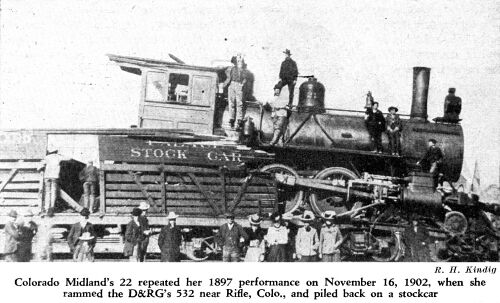 AN EVEN worse
hoodoo was the old Colorado Midland's 22, which balked or jumped
the rails at the slightest provocation. Her first major disaster
occurred in 1891 at Basalt, Colo., when she sideswiped an excursion
train, ripping off the boiler check-valve and sending a lethal
flow of scalding water into the day coach. AN EVEN worse
hoodoo was the old Colorado Midland's 22, which balked or jumped
the rails at the slightest provocation. Her first major disaster
occurred in 1891 at Basalt, Colo., when she sideswiped an excursion
train, ripping off the boiler check-valve and sending a lethal
flow of scalding water into the day coach.
But that was only a starter. Six years later, while pulling
an eastbound CM freight at New Castle, she rammed head-on into
a Rio Grande passenger train, piling up a frightful casualty list.
Among the dead were the 22's engineer, Fred Stiffler, his fireman,
and practically everybody in the day coach. After that, the new
hogger, Sheppard, was knocked down by a freight car and would
have been killed, he said, but for his guardian angel. One day
in 1909 the guardian angel must have gone away on a vacation,
for Sheppard made a ghastly mistake; he shot and killed a harmless
Mexican who he erroneously thought was chasing his wife. No wonder
men said the 22 was jinxed!
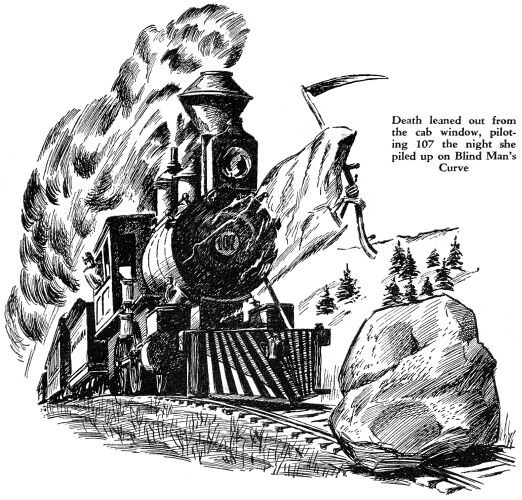 The real killer,
however, was Number 107 of the narrow-gage D&RG. Built in
1883, this mill had a diamond stack, a deckless cab, four, 48-inch
drivers and two pairs of pony-truck wheels, burned anthracite,
and could burnish the rails at better than a mile a minute. Mechanically,
she was a wizard. But the Old Man with the Scythe sat at her throttle.
Crews shuddered when they were called to take her out on a run,
not knowing whether or not they would be carried home on stretchers
or in coffins. Superstitious rails swore she was haunted by the
spirits of fourteen crew members she had killed. The real killer,
however, was Number 107 of the narrow-gage D&RG. Built in
1883, this mill had a diamond stack, a deckless cab, four, 48-inch
drivers and two pairs of pony-truck wheels, burned anthracite,
and could burnish the rails at better than a mile a minute. Mechanically,
she was a wizard. But the Old Man with the Scythe sat at her throttle.
Crews shuddered when they were called to take her out on a run,
not knowing whether or not they would be carried home on stretchers
or in coffins. Superstitious rails swore she was haunted by the
spirits of fourteen crew members she had killed.
Bill Duncan was the first hoghead to handle her on an ill-starred
trip. Josh Zuigley wielded the scoop. Leaving Grand Junction on
a pitch-black night with a passenger train, they ran into a bridge
washout in Black Eagle Canyon—and two funerals were held
as a result. The 107, lay in the canyon until late that summer.
After the river receded, she was raised and reconditioned.
Bill Godfrey was her next engineer. On a moonlit Christmas
Eve and with a fireman making his first run on the Division, Bill
pulled out of Gunnison and struck a 10-ton boulder on the far
side of Blind Man's Curve. The two enginemen and several passengers
answered the last call. Number 107 became known as "Dread
107." Uncanny tales were circulated about her. Demons and
ghosts were said to haunt her cab at night as she stood in the
roundhouse.
Even non-superstitious rails now fought shy of her. They found
all sorts of excuses for refusing to go near her throttle: So
she was transferred to the Salt Lake City-Ogden run, 80 miles
of rails in prairie country, in the hope that new scenery would
break the jinx. At first on the new run there were only minor
accidents, such as a couple of rear-end freight collisions in
which no one was hurt and a, derailment that killed a hobo riding
back of the tender.
Then Ole Gleason took her over. Ole had been railroading for
a decade and a half without a scratch. Friends said he bore a
charmed life. However, within six months after he set foot inside
of Dread 107, he was picked up a corpse. It was a cornfield meet,
and four other railroad men were plunged into eternity at the
same time.
Some unknown hand carved on the cab's woodwork the names of
all the men who had met death there, with the list and dates of
her wrecks. The jinx laid low for the next few years, insofar
as accident, were concerned, but misfortunes seemed to dog the,
footsteps of the 107's engine ,and traincrews. There were many
cases of sickness, death and ill luck of various kinds among the
men and their families, all of it attributed by the superstitious
to the hoodooed 107.
Then one day she ran away from the Ogden Yard, while Tom Flynn
was at the throttle, with his brother firing. The story is told
that Tom lost his mind from staring at the death roll carved on
the cab, fought savagely with his brother, tossed him out of the
cab to die of internal injuries, and then was found, a raving
maniac, pinned beneath his overturned engine!
When that story got out, nobody on the division would touch
the 107's throttle. So the brass hats transferred her to Alamosa,
in southwestern Colorado, on the other side of the Rockies. But
they had to deadhead her across the Divide; men shunned her cab
like the plague.
At Alamosa the old girl was overhauled and repainted, the ominous
death roll was eradicated, and her number was changed to 100.
For several years it was believed her spell was broken. But no!
The unrepentant killer rolled into a ditch at the time of a spring
freshet, and when she was brought back to Alamosa an amazing discovery
was made—her old number, 107, had somehow been restored!
Then came the last, terrible stroke. It was a beautiful, starlit
June evening. The hogger, Frank Murphy, scoffed at superstition.
He was faking the 107 from Mear's junction to Alamosa with a heavy
train of gravel, downgrade all the way. Six miles out of the junction,
his train ran away, and no member of the crew lived to tell what
happened. The runaway crashed into a light mixed train, killing
five good railroad men.
After that it would have taken a shotgun to get any engineer
into the cab of Dread 107. There was nothing to do, in the year
1908, but scrap her. Oldtimers were gleeful.
You can still find on the roaring road a belief in hunches
and the accidents that come in series of three, with here and
there a rabbit's foot or a lucky coin, but no, longer a deadly
hoodoo such as the man-killing 107.
Stories Page | Contents Page
|







